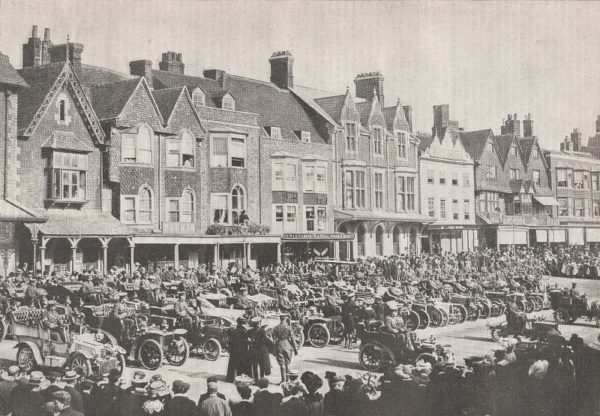
Our Snapshot shows the inspection by Lord Roberts of the Motor Volunteer Corps during the annual autumn manoeuvres on the Lambourn Downs, north-east of the Wiltshire market town of Marlborough in Wiltshire in whose main square this scene was captured. A report of the event in The Car Illustrated was positive: it celebrated the growing importance of the motor car in such military exercises. Lord Roberts, the opposing generals, and the foreign attachés were all said to have used “horseless carriages” during the manoeuvres.
Field Marshal Frederick Sleigh Roberts, 1st Earl Roberts, VC, KG, KP, GCB, OM, GCSI, GCIE, VD, PC, FRSGS (30 September 1832 – 14 November 1914), was a British Victorian era general who became one of the most successful British military commanders of his time. A man of small stature, Roberts was affectionately known to his troops and the wider British public as “Bobs” and was revered as one of Britain’s leading military figures at a time when the British Empire reached the height of its power.
The report in The Motor, from which our Snapshot comes, was more critical. Written by a Royal Artillery Lieutenant, it bemoaned the fact that not a single Motor Volunteer was employed as a combatant, and thus that the Motor Corps was deprived of all claims to be regarded as a serious military organisation. The writer continued in polemic tone: “It is not the fault of the corps at all; yet it still remains ridiculous to talk of their great value in the warfare of the future, when they are not given any opportunity of doing any military work at peace manoeuvres.” The motorcyclists (seen at the back right of our Snapshot) were used for carrying messages and despatches and were highly successful in this role.
Thanks to our good friend Ariejan Bos we have been able to identify some of the cars. From left to right, starting with the front row of three cars, they are:
First row: Panhard & Levassor; Mobile (probably); De Dion-Bouton.
Second row: New Orleans; Panhard & Levassor (this car belongs to Charles Rolls); Decauville; Panhard & Levassor (probably: this large light-coloured car has a conspicuous body, which the French would call a ‘charette anglaise’); unknown; Clément (surrounded by the group with Lord Roberts and therefore only visible on another photograph in The Car Illustrated); Lanchester (the sloping cover for driver and passenger can be spotted just above the head of the occupants in the Panhard on the first row); Panhard & Levassor (possibly); the small light-coloured car could be a Clément; Napier; unknown; unknown; Argyll; possibly Siddeley or Peugeot; invisible.
The cars on the third row are not visible.
Despite the criticisms in The Motor of the lack of military employment of the cars and their drivers, Ariejan observes that the cars are lined up in a cavalry formation: three in front, followed by two lines of cars. “Ready to attack …”, he writes.
Photo courtesy of The Richard Roberts Archive.







Leave a Comment